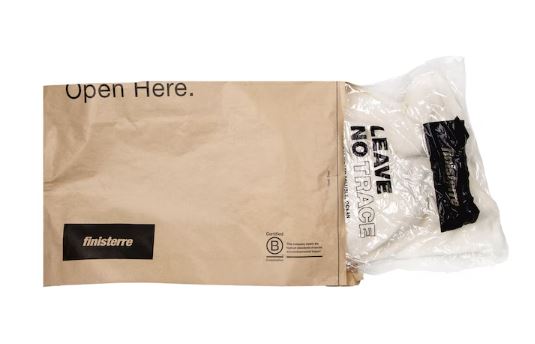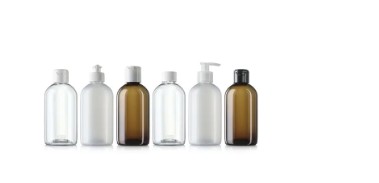The ocean-safe, biodegradable Leave No Trace bag is made from PVOH that can be disposed of by running warm or hot water over it.
A new garment bag from U.K. outdoor clothing brand Finisterre is said to literally “Leave No Trace.” The company, which was the first in its market to be named a B Corp business—a certification that measures a company’s entire social and environmental impact—has been, since its beginning in 2003, committed to the belief that it can make a truly exceptional product in a more responsible and sustainable way.
Finisterre is located on the cliffs of St Agnes in Cornwall, England, overlooking the Atlantic. Its products, including technical outerwear and built-for-purpose products that are made to last, such as knitwear, insulation, waterproof clothing, and base layers, is “built for adventure and inspires a love of the sea.” That’s according to Niamh O’Laoighre, Head of Product Development & Technical for Finisterre, who adds that it’s in the company’s DNA to strive for innovation. “And that doesn’t end in our clothing,” she shares. “It extends to all areas of the business, including packaging.”
In 2018, when Finisterre gained B Corp certification, it made a commitment to eradicate single-use, non-biodegradable plastics from its supply chain. “Plastic is everywhere,” says O’Laoighre. “It’s an incredibly useful material in its lifecycle, but its end of life is a bit of a problem. There are an estimated 8 million metric tons of plastic going to our oceans every year. And it’s thought that there’s now more microplastic in the seas than stars in the Milky Way.”
When the company learned of biodegradable and compostable plastics supplier Aquapak, O’Laoighre says it had been looking for a solution that could replace its polyethylene garment bags for some time. “But we couldn’t find quite the right one to tick all our boxes,” she explains. “We needed something with multiple end-of-life solutions that were accessible to everyone—consumer, retailer, manufacturer—and crucially, something that, should it leach into the natural environment, would break down completely and leave no microplastics.”
Aquapak’s Hydropol polyvinyl alcohol technology resin ticked all those boxes. PVOH, also known by the acronym PVA, is a naturally water-soluble thermoplastic that is fully biocompatible and non-toxic. One drawback for packaging applications, however, is its thermal instability—an issue that Aquapak says it’s overcome with Hydropol.
“The key to the exploitation of this known and highly functional polymer is in the processing and the additive chemistry, which enables thermally processible Hydropol to be produced, unlike historical PVOH systems that were very limited in their application potential because of their thermal instability,” shares Dr. John Williams, Chief Technology Officer for Aquapak. “This stable processability has opened up the functionality—strength, barrier, end of life—to the mainstream packaging industry, thereby allowing the development of packaging constructions that are both functional and recyclable/biodegradable. The careful choice of proprietary additive technology retains the property of biodegradability in water.”
According to Aquapak, Hydropol is completely dissolvable in warm and hot water, without leaving residue; is UV-resistant; provides a barrier against oil, fat, grease, gas, and petrochemicals; is breathable to moisture; provides an oxygen barrier; is strong and puncture-resistant; and is marine safe, completely biodegrading in marine environments, where it is safe to both marine plant and wildlife. In addition, the standardized pellet form of Hydropol’s resin means it can be directly integrated into existing manufacturing processes.
According to Dr. Williams, Finisterre’s requirements for the new material were that it be marine safe, clear, printable, and strong, as well as able to be processed on existing converting equipment. The development process for the Hydropol-based garment bag spanned nearly a year and involved tailoring the solubility of the resin to meet the application.
The resulting bag, branded by Finisterre as its Leave No Trace bag, is made from Aquapak’s Hydropol 30164P monolayer blown film. Copy on the clear bag explains that it is “water soluble, ocean safe, and biodegradable, breaking down harmlessly into non-toxic biomass in soil and sea.”
On its website, the company advises its customers, “If you’re wondering how to safely dispose of your Leave No Trace bag, all you’ll need is a kettle and your sink. The material breaks down quickly and harmlessly in water temperatures above 70ºC. Should your bag end up in landfill, it will biodegrade naturally and Leave No Trace.”
The bags can also be recycled, the company adds. “The material can be readily identified by sorting methods such as infrared and laser sorting and can therefore be separated and reprocessed,” it explains. “In less sophisticated waste-handling facilities, the use of hot water wash enables Hydropol to be taken into solution. Once in solution, the polymer can either be recovered, or the solution is allowed to go to normal wastewater treatment or anaerobic digestion.”

Finisterre’s new mailer is lighter than the kraft bag it had been using previously, with a film barrier made from Aquapak’s Hydropol material.Following on the heels of its Leave No Trace garment bags, Finisterre introduced a new and notably lighter mailer to replace the heavyweight kraft bag it had been using to mail its products. The bag was developed by Finisterre in partnership with Aquapak and converter EP Group. Now known as the Flexi-Kraft mailer bag, the package features a layer of Hydropol 33104P coextruded blown film laminated to kraft paper using a solvent-free adhesive. The Hydropol layer is said to give the bags strength and flexibility as well as tear resistance. The PVOH layer also enables the bags to be much lighter than pure paper mailers and to be heat sealed for a stronger seal.
“Using 70% less paper than our old mailbags, this new packaging combines lightweight paper laminated with our water-soluble Leave No Trace material, to create a sturdy mailbag that can be safely added to your household paper recycling and dissolves in the pulping process of paper recycling,” says the company.
“Lining our mailbags with this new material reduces bag weight by 50% while increasing paper strength by 44%, all with fewer materials,” it adds. “That means less resources used both in production and transportation.”
Despite the fact that the use of Hydropol has significantly impacted the cost of Finisterre’s packaging—in the case of the garment bag, up to four to five times more than the cost of PE— O’Laoighre said the increase is one the company is willing to bear. “As a company committed to doing business better, it is a very important project, and one we believe in,” she says. “We were incredibly proud to be the first clothing company in the world to use this packaging technology, and we’re offering it open source to other brands that want to use it, because together we can make a bigger difference.”
Source:







